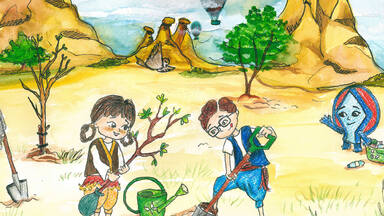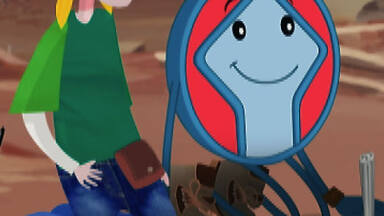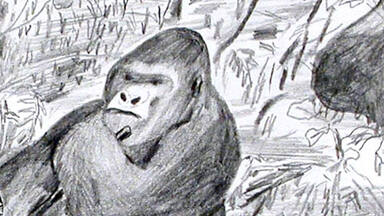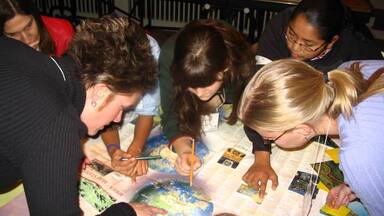After launching the Patrimonito Storyboard Competition in 2022, the World Heritage Centre received over 700 submissions from young people featuring solutions to the impacts of climate change on World Heritage sites.
Climate change is the defining issue of our time and amongst the greatest threats facing cultural and natural heritage today. Involving the youth is essential to finding smart solutions and building a community to tackle challenges of the upcoming decades. Providing young people with an opportunity to use their creative and problem-solving skills to raise awareness about World Heritage and Climate Change, the “Patrimonito's World Heritage Adventures” Storyboard Competition was launched on the 29th of July, 2022 by the World Heritage Centre.
The World Heritage Centre received a total of 710 storyboards from 47 State Parties. The top 5 countries with the most submissions were 1) China (261 submissions), 2) Qatar (70 submissions), 3) Oman (39 submissions), 4) Malaysia (29 submissions) and 5) Serbia (28 submissions). The average age of participants was 14 years old, and the storyboards were submitted independently or through schools, Ministries of Education and National Commissions for UNESCO.
The winning storyboard was selected by an independent jury composed of heritage specialists, on November 30th 2022. The evaluation was based on drawing skills, originality of the story, knowledge of World Heritage site, relevance of the problem presented regarding climate change and viability of the chosen solution.
The Winner
1st Place
Ebru Goban
12 years old, from Türkiye
World Heritage sites featured: Göreme National Park and the Rock Sites of Cappadocia, Ephesus, Nemrut Dağ and Göbekli Tepe in Türkiye
School: Yunus Emre Secondary School
Storyboard created by Ebru Goban, winner of the Patrimonito Storyboard Competition 2022 © UNESCO | Ebru Goban, Türkiye
2nd Place
Liu Boyou
16 years old, from China
World Heritage sites featured:
Cultural Landscape of Honghe Hani Rice Terraces in China
School: Tsinghua University High School
Storyboard created by Liu Boyou for the Patrimonito Storyboard Competition 2022 © UNESCO | Liu Boyou, China
3rd place
Da’as Lamar
16 years old, from Qatar
World Heritage sites featured:
Petra in Jordan
School: Al-Ebb Secondary School
Storyboard created by Da’as Lamar for the Patrimonito Storyboard Competition 2022 © UNESCO | Da’as Lamar, Qatar
The World Heritage Centre gratefully acknowledges all the young people from around the world who participated in the Storyborad Contest and commends them for their commitment to the protection, preservation and promotion of World Heritage.
Watch the episode
Watch
Englsih French Russian Arabic Spanish Chinese
Download
Patrimonito’s World Heritage Adventures cartoon series
Patrimonito’s World Heritage Adventures cartoon series is a flagship activity carried out under the World Heritage Education Programme, since 2002. The cartoon series aims to raise the awareness of the importance of heritage preservation among the youth, through a “by young people, for young people” approach, inviting them to convey the message of World Heritage preservation to their peers.
So far, 15 episodes of Patrimonito’s World Heritage Adventures have been produced and are available to the greater public through the UNESCO World Heritage Website and the UNESCO social media channels.
The character of Patrimonito
The character of Patrimonito was created on the basis of the World Heritage Emblem by a group of Spanish-speaking students at the First World Heritage Youth Forum held in Bergen, Norway in 1995. Patrimonito means “small heritage” in Spanish and represents a young heritage guardian.
Patrimonito has since then been widely adopted as the international mascot of World Heritage Education Programme. Since 2002, Patrimonito is also the main character of the Patrimonito´s World Heritage Adventures cartoon series.
Storyboard Competition Theme:
World Heritage and Climate Change
Climate change is the defining issue of our time, and among the greatest threats facing cultural and natural heritage today. Many of the natural sites and cultural heritage sites inscribed on the Worle Heritage List are currently threatened by climate change.
In recent months and years, we have seen cultural and natural heritage sites, including many World Heritage sites, threatened by wildfires, floods, storms and mass-bleaching events. Climate change puts living heritage – oral traditions, performing arts, social practices, festive events, and traditional knowledge – at risk as well. As climate change leads to displacement and forced migration, entire ways of life risk being lost forever.
While this challenge of Climate Change is monumental, one can also take inspiration from heritage towards climate action. World Heritage properties also harbour options for society to mitigate and adapt to climate change through the ecosystem benefits, such as water and climate regulation. Cultural heritage, on the other hand, can convey traditional knowledge that builds resilience for change to come and leads us to a more sustainable future. It is hence crucial for all generations to help raise awareness on the impacts of climate change on human societies and cultural diversity, biodiversity and ecosystem services, and the world’s natural and cultural heritage.
In this context, we invite young people from around the world to reflect on the pressing issue of Climate Change, and its impact on the World Heritage sites around them, and the solutions or measures in their opinion, that would help address these challenges.
Who Can Participate?
The Patrimonito storyboard competition is open to young people from all over the world aged between 12 and 18 years old.
The artworks must be created solely by the participant(s), either by hand or using digital drawing tools. In either case, the scanned copies must be submitted by email OR the original copies (in case of hand-drawn entries) or the print versions (in case of digital artworks) must be submitted by postal mail to UNESCO. Participants may also choose to submit their entries through their countries’ National Commissions for UNESCO.
How to Participate
Storyboard creation
Preparing a storyboard is like drawing a comic book. It is a script that presents a story through sketches in chronological sequence. Usually, a storyboard is drawn in pencil, ink, or through digital drawing tools. The images or visual illustrations of the story are portrayed using a series of frames.
The story and drawing should reflect:
- the participant’s knowledge of the World Heritage site they have chosen and the exceptional value of the site.
- a challenge/problem faced by the site based on the impacts of Climate Change
- the solution or measures proposed by the participant to the challenge/problem.
Blank storyboard worksheets should be used for drawing the cartoons. The worksheets give the participants a series of frames that will show the development of the action or story.
Structure of the storyboard
- Participants should reflect on the story they would like to convey to the audience on the theme of Climate Change. Patrimonito should play one of the main roles among the characters, and there should ideally be two more main characters - a young girl and a boy.
- The script will need 'shape' - this means it needs a beginning, middle, and an end.
- Beginning: The participants should set up story and characters in relation to the selected World Heritage site.
- Middle: This is the backbone of the story. Here, they should present the obstacles or problems that the characters must overcome; or perhaps if there were no obstacles, an interesting journey, or series of coincidences that they experienced. Participants should communicate main message in this section.
- End: This is the conclusion of the story where everything should fall together, depicting how the problem should be resolved in the participant’s view, and giving the end of the story.
- Participants should balance the presentation of the story. They should consider the number of frames devoted to the description of the site, to the issue confronted by the site, and to the solution they propose.
Download Information about how to create a storyboard as well as a worksheet sample.
Submitting the Storyboards
If sent by email
The scanned version of the storyboards should be sent to the World Heritage Centre by email: PatrimonitoCompetition@unesco.org
If sent through postal mail
The original copies (in case of hand-drawn entries) or the print versions (in case of digital artworks) must be submitted to the attention of:
Ms Ines Yousfi
Focal Point, World Heritage Education Programme
UNESCO World Heritage Centre
7, place de Fontenoy,
75352 Paris 07 SP France
If sent through National Commissions for UNESCO
The participants may also choose to submit their entries through their countries’ National Commissions for UNESCO.
Deadline for submissions
The storyboards must be received at the latest by:
16 October 2022, 23:59 CET.
Selection and Results
The winning entry will be selected by the independent jury established by the World Heritage Centre, comprising heritage and education experts. The winner will receive a UNESCO certificate, and the winning storyboards will be professionally adapted into an animated film episode of the Patrimonito’s World Heritage Adventures series.
The name of the creator of the winning storyboard will be credited in the film which will be distributed worldwide by UNESCO and its partners. The release of the next episode is scheduled for 2023.
Background information
Participants can find background information on the World Heritage Convention at: https://whc.unesco.org/
They can also discover the World Heritage List and the sites inscribed in and around their region at https://whc.unesco.org/en/list/
Resource links on the theme of Climate Change and World Heritage are available at: https://whc.unesco.org/en/climatechange/









